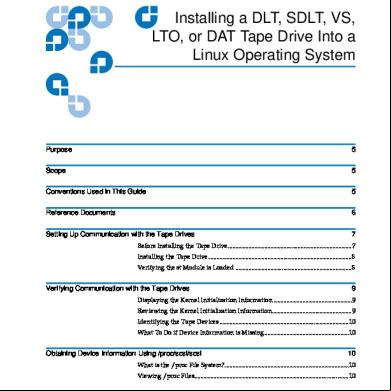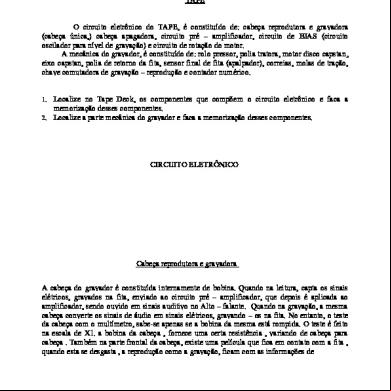Problems In Tape Measurements 4j1128
This document was ed by and they confirmed that they have the permission to share it. If you are author or own the copyright of this book, please report to us by using this report form. Report 3b7i
Overview 3e4r5l
& View Problems In Tape Measurements as PDF for free.
More details w3441
- Words: 638
- Pages: 2
Problem 1. A rectangular lot was being measured using a 30m metallic tape which was 6mm too long. The recorded dimensions where 70.50 m long by 37.10 m wide. a) What is the error due to the erroneous tape? b) What are the actual dimensions of the lot?
Problem 2. A line is recorded as 472.90m long. It is measured with a 0.65kg/m tape which is 30.005 m long at 20°C under a 50N pull ed at both ends. During measurement the temperature is 5°C and the tape is suspended under a 75N pull. The line is measured on a 3% grade. What is the true horizontal distance? E is 200GPa, cross-sectional area of the tape is 3 mm 2 and the coefficient of thermal expansion is 0.0000116 (m/m-°C). Problem 3. A 30 m steel tape is 2mm too long at 20°C with a pull of 55N. A rectangle is measured with this tape. The sides are recorded as 144.95 m and 113 m. The average temperature during the measurement is 30°C with a pull of 55N. a) If the recorded measurement are used , will the computed area of the field be too small, or too big and why? b) What is the error in the area? Use coefficient of thermal expansion of steel tape as 0.0000116 (m/m-°C)
Problem 6. A baseline was measured using a 100m tape which is standardized at 15°C with a standard pull of 10kg. The recorded distance was found to be 430.60 meters. At the time of measurement, the temperature was 20°C and the pull exerted was 16kg. Determine the true length of the base line if the weight of one cubic cm steel is 7.86 grams. Weight of tape is 2.67 kg. E is 2 x 106 kg/cm2 and K is 7 x 10-7 (m/m-°C) Problem 7. An engineer’s chain was used to measure a line, there were 6 tallies (1 tally = 10 pins) recorded, the rear chainman had 5 marking pins (1 pin = 100 links) and the distance from the last pin to the end of the line was 51.10 links ( 1 link = 1 foot), what was the length of the line?
Problem 8. A 100m steel tape standardized at 20°C had a length of 100.06 m. it was used to measure a line A to B on a slightly sloping ground. The recorded tape distance was 622.70m. The temperature at the time of measurement is 29°C. the stadia distance for the same line was only 560.0 m. Upon investigations, the discrepancy was found out to be due to the fact that a 10m length (between 75m and 85m was cut off. a) What is the true length of the sloping line? b) What is the horizontal distance of the same line if the difference of elevation between A and B is 0.72m.
Problem 4. The distance measured with a 50m steel tape is recorded as 696.41m. The tape is known to be 0.015 m too short. What is the correct length of the line? Problem 5. A steel tape is 100m long at 60°C with a pull of 10 kgs. A line was measured and found to be 510.02m when the temperature was 65°C using the same pull. If the coefficient of the thermal expansion of the tape is 0.0000065 (m/m-°C), what is the correct length of the line?
K is 0.0000116 (m/m-°C) Problem 9. A rectangular field was measured using a 100m tape which was actually 10 cm too short. The recorded area was 2500 m². what is the true area of the field? Problem 10. A steel tape is known to be 50 m long at 10°C. if the coefficient of thermal expansion is 0.0000116 (m/m°C), what distance should be taped to set two monuments exactly 1000m apart when the temperature is 26°C.
Problem 2. A line is recorded as 472.90m long. It is measured with a 0.65kg/m tape which is 30.005 m long at 20°C under a 50N pull ed at both ends. During measurement the temperature is 5°C and the tape is suspended under a 75N pull. The line is measured on a 3% grade. What is the true horizontal distance? E is 200GPa, cross-sectional area of the tape is 3 mm 2 and the coefficient of thermal expansion is 0.0000116 (m/m-°C). Problem 3. A 30 m steel tape is 2mm too long at 20°C with a pull of 55N. A rectangle is measured with this tape. The sides are recorded as 144.95 m and 113 m. The average temperature during the measurement is 30°C with a pull of 55N. a) If the recorded measurement are used , will the computed area of the field be too small, or too big and why? b) What is the error in the area? Use coefficient of thermal expansion of steel tape as 0.0000116 (m/m-°C)
Problem 6. A baseline was measured using a 100m tape which is standardized at 15°C with a standard pull of 10kg. The recorded distance was found to be 430.60 meters. At the time of measurement, the temperature was 20°C and the pull exerted was 16kg. Determine the true length of the base line if the weight of one cubic cm steel is 7.86 grams. Weight of tape is 2.67 kg. E is 2 x 106 kg/cm2 and K is 7 x 10-7 (m/m-°C) Problem 7. An engineer’s chain was used to measure a line, there were 6 tallies (1 tally = 10 pins) recorded, the rear chainman had 5 marking pins (1 pin = 100 links) and the distance from the last pin to the end of the line was 51.10 links ( 1 link = 1 foot), what was the length of the line?
Problem 8. A 100m steel tape standardized at 20°C had a length of 100.06 m. it was used to measure a line A to B on a slightly sloping ground. The recorded tape distance was 622.70m. The temperature at the time of measurement is 29°C. the stadia distance for the same line was only 560.0 m. Upon investigations, the discrepancy was found out to be due to the fact that a 10m length (between 75m and 85m was cut off. a) What is the true length of the sloping line? b) What is the horizontal distance of the same line if the difference of elevation between A and B is 0.72m.
Problem 4. The distance measured with a 50m steel tape is recorded as 696.41m. The tape is known to be 0.015 m too short. What is the correct length of the line? Problem 5. A steel tape is 100m long at 60°C with a pull of 10 kgs. A line was measured and found to be 510.02m when the temperature was 65°C using the same pull. If the coefficient of the thermal expansion of the tape is 0.0000065 (m/m-°C), what is the correct length of the line?
K is 0.0000116 (m/m-°C) Problem 9. A rectangular field was measured using a 100m tape which was actually 10 cm too short. The recorded area was 2500 m². what is the true area of the field? Problem 10. A steel tape is known to be 50 m long at 10°C. if the coefficient of thermal expansion is 0.0000116 (m/m°C), what distance should be taped to set two monuments exactly 1000m apart when the temperature is 26°C.










